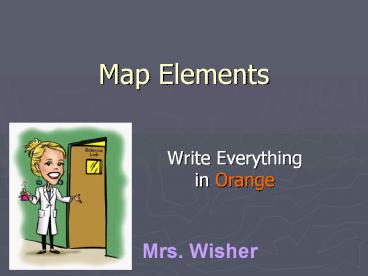Mapping Notes - PowerPoint PPT Presentation
Title:
Mapping Notes
Description:
notes on mapping – PowerPoint PPT presentation
Number of Views:26
Title: Mapping Notes
1
Map Elements
- Write Everything in Orange
Mrs. Wisher
2
Maps
- Maps a model on a flat surface
- Globe a sphere that represents Earths surface
3
Types of Maps
- Road Maps
- Political Maps- shows city, state, country
boundaries - Topographic Maps-used by Geologists/Outdoorsman
4
Latitude and Longitude
- The earth is divided into lots of lines called
latitude and longitude.
5
Lines
- Longitude lines run from north pole to south
pole. - measure distance east or west of prime meridian
- Latitude lines run from east to west.
- measure north and south of the equator
- The lines measure distances in degrees.
6
Longitude Latitude
Longitude
Latitude
7
Where is 0 degree?
- The equator is 0 degree latitude.
- It is an imaginary belt that runs halfway point
between the North Pole and the South Pole.
Equator
8
Where is 0 degree?
- The prime meridian is 0 degrees longitude.
- This imaginary line runs through the United
Kingdom, France, Spain, western Africa, and
Antarctica.
9
(No Transcript)
10
Hemispheres
- By using the equator and prime meridian, we can
divide the world into four hemispheres, north,
south, east, and west.
11
Questions?
- Which hemisphere is the United States in?
12
Questions?
- Which hemisphere is the United States in?
- Northwestern Hemisphere
13
(No Transcript)
14
Compass
- A compass is a tool that helps the user know what
direction one is headed. - On a map, a compass or a compass rose helps the
user locate these directions.
15
Questions
- What is 0 degrees longitude?
16
Questions
- What is 0 degrees longitude?
- Prime Meridian!!!
17
Compass
- The needle on a compass is magnetized to point to
the earth's north magnetic pole. - Thus with a compass, a person can roughly tell
which direction they are headed.
Source http//aerocompass.larc.nasa.gov
18
Directions
- The cardinal directions are north, south, east,
and west. - The intermediate directions are northeast,
southeast, southwest and northwest.
19
Scale
- Maps are made to scale that is, there is a
direct connection between a unit of measurement
on the map and the actual distance. - For example, if an inch on the map represents one
mile on Pavilion Center from Alta northward, what
would it show?
20
(No Transcript)
21
Questions
- What direction does a compass needle point to?
22
Questions
- What direction does a compass needle point to?
- A compass always points north!
23
Time Zones
- The Earth is divided into 24 time zones,
corresponding to 24 hours in a day. - Places that have the same longitude will be in
the same time zone.
24
(No Transcript)
25
Map Legends
- The legend is the key to unlocking the secrets of
a map. Objects or colors in the legend represent
something on the map.
26
Can you understand this legend?
27
Topography
- The lay of the land.
- Shows relief using contour lines.
- Relief- highs and lows of Earths surface.
- Relief can be calculated
- Take the difference between the highest point and
the lowest. - Ex Mountain peak 20 m. lake 10m
- 20m- 10m 10m
- The relief of this area is 10m
28
Contour Lines
- Lines on topographic maps.
- Connect points of equal elevation.
- Everything connected to that line has the same
elevation. - Elevation- the distance something is above sea
level. Sea level 0m or 0ft.
29
Contour lines
- Contour interval- gives the difference in
elevation between 2 contour lines. - Another indicator of height.
- Used to count contour lines
30
Contour Map
31
Questions?
- Close your notebooks, all people at C seats,
describe to your table the purpose of contour
lines.
32
Depression Contours
- Depression contours show areas of lower
elevation. - Drawn like contour lines with marks on the
inside.
33
Hills
- Hills are represented on a topographic map by a
series of concentric contour lines in a rough
circle
34
Slope
- Closely spaced contour lines represent steep
slopes. - Widely spaced contour lines represent gentle
slopes.
35
Questions
- All people at the A seats, tell your table how
you tell the difference between a hill or a
valley on a contour map.

